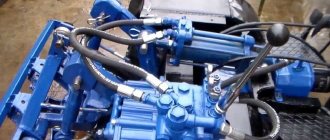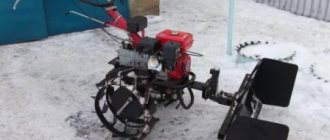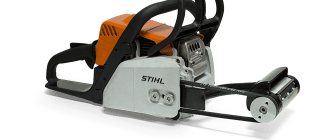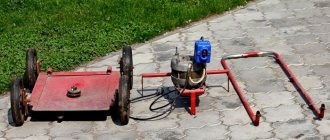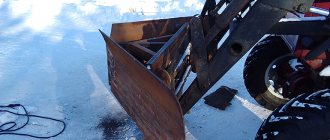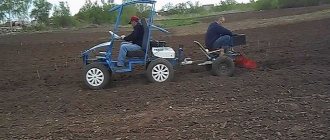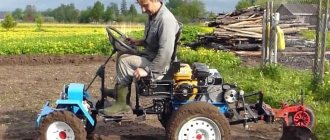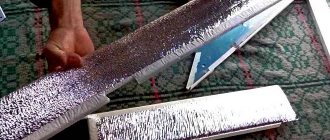Gone are the days when trenches and holes had to be dug by hand with a shovel. Now the owners of private houses have shifted this type of hard work onto the shoulders of special mini-equipment. For this purpose, the industry began to produce trenchers - compact and maneuverable devices for walk-behind tractors.
Adapt your tiller for trenching
Trencher for walk-behind tractor
The production of mini-tractors and attachments for small equipment helped owners from the private sector shift manual labor to the shoulders of machines. Attachments on walk-behind tractors for digging trenches are also used by owners of personal plots and landscape designers in cramped environments, when the maneuverability of mechanisms, productivity and low cost of work performed are important.
Description
Do-it-yourself duck house: do-it-yourself pen, duck shed made of wood and brick, conditions for keeping birds.
A trencher for a walk-behind tractor is equipment that can make life many times easier for its owner, who is planning to lay communications, carry out gardening and other work, where without digging long and narrow trenches are indispensable.
Of course, there are special motorized units - industrial-level trenchers, the digging depth of which can reach 1 meter 20 centimeters. Smooth, strong cuts of the cut hold their shape perfectly and do not crumble. This is excellent equipment; its only drawback is its high cost, available only to specialized organizations.
What should owners of private houses and land do when a shovel is not able to help, but they have a walk-behind tractor on the farm? And then a real way to solve the problem appears - an attachment on a walk-behind tractor for digging trenches. Digging trenches with a walk-behind tractor will take much less time and effort, which will also have a beneficial effect on labor productivity.
What does it represent?
A mounted trencher on a walk-behind tractor is a kind of mini-excavator, maneuverable and compact.
It is used in cramped operating conditions between outbuildings, individual buildings, trees, bushes, and on slopes. Walk-behind tractors for trenchers have a reliable wheeled or tracked base and are equipped with specially designed cutting elements.
Manufacturers are striving to expand the functionality of the trencher and provide for the installation of various cutters, blades, plows that provide trench digging at depths of up to two meters...
What is it used for?
The equipment is used for the following work:
- digging ditches, holes, trenches;
- loosening the soil;
- tree planting;
- arrangement of foundations;
- drainage, reclamation...
Digging a trench with a walk-behind tractor is not difficult. In addition, after the ditch digger, neat trench walls remain, which reduces the risk of landslides, soil shedding and allows you to dig a trench with a walk-behind tractor in the ground: frozen, weakly stable...
The operation of a ditch digger is accompanied by:
- minimal volumes of soil after constructing the trench;
- absence of significant surface damage;
- neat cuts of the edges of the trench, without collapsing the soil;
- compactness;
- reasonable price;
- ease of maintenance.
The attachment to the walk-behind tractor for digging trenches makes the work easier and does not require removal of the excavated soil. The soil loosened by the augers can be easily returned to the trench after completion of the laying work.
Basic information
In industrial construction, excavators have always been used to lay ditches for pipelines, electrical network cables, and communications.
A walk-behind trencher is a compact and maneuverable mounted mini-excavator. Land owners use it for the following purposes:
- digging holes, ditches;
- removal of the top layer of road surface that has become unusable;
- cutting out soil layers;
- loosening the soil;
- preparing the site for planting;
- arrangement of the foundation;
- land reclamation;
- drainage.
There are 2 types of trenchers:
- Whole. This mechanism is integral with the walk-behind tractor. Most often it is used by landscape designers and professional builders. The most popular models are Barreto 912HM, Laski TR50/CH270/50, Sable /BS/50 and Ground Hog T4.
- Mounted. Produced by the manufacturer specifically for a specific type of walk-behind tractor. In the CIS markets, a mounted trencher is presented by Quick Attach and is called Trench It. The soil cutter has dimensions of 1.025x0.61x2.01 m, weight - 272 kg, lays trenches 0.96 m deep. It is used for aggregation with walk-behind tractors from world manufacturers Yanmar, Bobcat, Case, Daewoo, John Deere using special couplings.
Read also How to install a boiler in an apartment with your own hands
Solid equipment is very expensive, so it is in demand only among professionals.
The main criteria for evaluating trenchers are:
- digging depth;
- trench length;
- speed of work.
Mounted units have the following advantages:
- minimum soil after excavation in the digging area;
- the possibility of using soil for other purposes;
- compactness;
- high reliability of components and connections;
- low fuel consumption;
- no damage to the soil surface;
- accuracy of work;
- smooth edges of the trench (the earth does not fall back into the hole);
- high performance when working with frozen soil;
- simple operation and maintenance;
- affordable price;
- lack of permitting documents.
It is difficult for a user to choose the best model among a wide variety of diggers. All of them are designed to work in different conditions and achieve specific goals. Digging depth and productivity depend on the weight and power of the unit. The price directly depends on these factors.
Selecting the right model
It is difficult for the user to select the required brand among the variety of ditch diggers.
The performance of the unit depends on the power of the walk-behind tractor, weight, depth and width of trench digging with attachments. These same factors dictate the price. Two types of ditch diggers are practiced:
- Trenchers, which are created as a single, integral mechanism with an aggregate. In practice, the most common brands are: Laski TR 50/TR 60, TKG-1200, Barreto 912 HM. This technique is very expensive and is designed for professional use.
- Mounted ditch diggers. They are produced by factories for certain types of power units. Selecting a ditch digger for a walk-behind tractor is very difficult.
In the countries of the former Soviet Union, the Trench It attachment, developed by Quick Attach, is used, which is assembled with specially designed couplings, with units from John Deere, Case, Yanmar, Daewoo, Yanmar.
Equipment for laying trenches, aggregated with BELARUS tractor equipment
The basis of the fleet of attachments for laying trenches in post-Soviet countries are trenchers using tractor machines of 0.9-1.4 traction levels as base machines, most of which are tractors produced by MTZ.
Soil cutting unit BGM-2
The BGM-2 trencher, aggregated with the BELARUS 82, is used for laying rectangular trenches when laying pipeline networks, power supply and communication lines and other utilities.
Equipped with a hydraulic drive for lifting the working body, the trencher digs a trench 0.21, 0.270 or 0.41 meters wide with a maximum depth of 1.6 meters in one pass at above-zero temperatures.
The complex, weighing 6.6 tons with transport dimensions of 6,650 x 2,060 x 2.80 meters, is equipped with a winter cutting chain device, which makes it possible to lay trenches with a width of 0.14 meters in frozen soil.
Soil cutting unit ETC-2086
The ETC-2086 trencher, which is several times higher than the productivity of conventional excavator equipment when laying trenches, and is intended for digging trenches when laying various communication and utility networks.
Equipped with a base chassis power take-off driven cutting chain operating mechanism that reaches a speed of 0.89 meters per second, the 2,450 tonne unit with dimensions of 7.9 x 2,240 x 3,200 cuts trench widths of 0.140, 0.27 and 0.40 meters and a maximum depth of up to 1.6 meters.
Trencher 2086.51.00.000
Designed for laying trenches up to 1.7 meters deep and 0.28 meters wide in soils of categories 1-4 during the construction of utility networks for various purposes and communications, the soil cutting machine 2086.51.00.000, equipped with an alligator chain, is designed to work with BELARUS 82.1.
Trencher for walk-behind tractors and mini-tractors Trench It
Aggregated with mini-loaders and walk-behind tractors, Trench It is used for laying trenches with difficult access for large equipment near walls and other building structures.
The device with dimensions of 1.025x0.61x2.01 meters and a weight of 272 kilograms allows for the laying of trenches with a depth of 0.96 meters.
How to make a trencher for a walk-behind tractor yourself?
The attachments offered by manufacturers are expensive and can only be combined with certain walk-behind tractors.
For this reason, many “Kulibins” decide to make a mounted homemade trencher with their own hands. The design is based on a homemade bar for a walk-behind tractor. There is nothing superfluous. Each part of the mechanism plays its role to facilitate the operator’s work. For these purposes, road milling cutters, homemade teeth, a factory chain, a moldboard shovel or auger, and protective covers are used.
Trenchers can be equipped with walk-behind tractors from Neva, MTZ, Kaska, Agro with a power of at least 8 hp. With.
The attachment to the walk-behind tractor for digging trenches is installed as follows:
- A homemade bar for a walk-behind tractor with cutting cutters is mounted on the front suspension.
- A homemade auger or mouldboard shovel is mounted on the rear suspension to clear trenches and remove soil.
- The cutting mechanism and chain drive must be covered with a protective casing to avoid injury.
Buy or rent
If you are involved in an activity that requires the regular use of the described units of special equipment, then it would be more advisable to purchase it than to lease it. However, it should be borne in mind that a manual small-sized trencher can cost you 150,000 rubles. minimum. The maximum cost reaches 500,000 rubles.
If you are purchasing a trencher to solve a specific task, then it is better to rent it. The machine is selected individually, and the leasing cost usually includes the operator’s labor, as well as the cost of additional materials.
Trencher in action
The operation of the unit is simple: after starting the cutting mills, digging a trench begins.
Next, the chassis drive is started, which causes the device to move, and the auger or blade shovel moves the excavated soil on the surface away from the clearing. Of course, a homemade device for digging a trench with a walk-behind tractor makes the work easier, saves time, effort, money, and turns ditch digging into a routine procedure.
Trencher Information
Although it is possible to dig trenches by hand, the use of specialized equipment is still more profitable.
Here are some reasons for this:
- During the work, the trench is narrow, deep and with steep edges. With this method of digging, the risk of crumbling the walls is reduced.
- The quality and efficiency of the unit does not suffer if the soil is denser than usual.
- When this mechanism works, the need to remove excavated soil is significantly reduced.
- When compared with an excavator, it should be noted that the excavated soil can be used at any time to fill the hole. In this case, the excavator can dig up blocks that must be broken before use.
- This mechanism has high performance.
- The ditch digger works effectively in winter conditions when it digs trenches in frozen ground.
Working body: bar soil cutter
Bar soil cutting machines are used for cutting cracks in frozen and hard soils when digging trenches and pits; cutting narrow trenches (when working with one bar) intended for laying communication lines and electrical cables; works on cutting limestones and sandstones; cutting blocks around tree plantations during their winter replanting; destruction of frozen soil peaks. The speed of excavating material from a trench using a specialized trench excavator can be six times faster than that of a conventional excavator. Moreover, a trench excavator removes just enough material to lay the pipeline, leaving the trench clean and ready for the final installation of pipes or cables. Finally, the material removed by such an excavator has a uniform particle size structure and can be used for backfill, whereas the material removed by a conventional excavator may contain large blocks that require additional destruction. These advantages provide high productivity, 4.5 times greater compared to traditional technology, and, accordingly, profitability of specialized trenchers where there is sufficient volume of work. In construction, bar machines of various modifications are used, cutting 1. 3 slots with a width of 140. 500 mm and a depth of 1 to 6 m. The cutting speed, depending on the number of slots, cutting conditions and the strength of the soil or rock being mined, is 2. 1000 m/h. The most effective bar machines used in construction are those equipped with high-strength teeth and bar chains, as well as base machine creepers, pile ejectors, augers and other hydraulic control and drive systems. It must be taken into account that for different types of soil, bar canopies may differ in the design of the drive mechanisms. The chain is usually driven from the tractor's hydraulic system or mechanically from the rear PTO of the base tractor. Electric and combined drives are extremely rarely used. Read more, or see more DIY wheeled mini excavators.
DIY trencher for walk-behind tractor
In order to make a trencher for a walk-behind tractor with your own hands, you need to meet the following conditions:
- A cutting system must be provided.
- The weight should not be too heavy.
- You need to remember that it needs to be connected to a walk-behind tractor.
- The design of a homemade trencher made from a walk-behind tractor must include an acceptable power plant.
The work takes place in the following sequence:
- It is necessary to attach a cutting system to the front suspension, in accordance with the drawing (it includes a chain, cutting elements attached to it),
- A dump shovel is placed on the back, it clears the bottom of the ditch from the earth.
- It is necessary to install a protective cover on the chain and on the cutting discs.
When turned on, the rotation from the walk-behind tractor is transmitted to the rotation of the chain. In this case, no torque should be transmitted to the running chain. At the same time, the rotation of the disks begins, which cut the trench. The dump shovel picks up the excavated soil and moves it to the side.
Manufacturing of other hanging structures
The walk-behind tractor can be equipped with a variety of useful devices - a plow, a rake, all kinds of shovels, mowers, skis, brushes. Desire, clear diagrams and descriptions of work will help you replicate store-bought analogues of hanging elements and even improve them, since they will meet individual requirements and conditions.
So, to cultivate the land you need a plow that can overcome virgin soil, overgrown with grass, wet or stale soil. To make it you will need a steel plate about 5 mm thick. Using rollers, the plate is bent into a cylinder. The edges are sharpened with a grinder.
Using the same principle, it is easy to make an attachment that forms furrows. It’s good if there are cultivator stands. They can be attached to a corner or two racks can be made from scrap materials. To do this, plates are cut from a metal sheet 1.5-2 mm thick. The size of the plates should correspond to the depth and width of the furrow. They are fastened with bolts to the racks of the structure. This attachment can be used for instillation. You just have to give the plates the required shape. They must be in the form of a disk or circle, located at a certain angle. Such plates are located closer at the top than at the bottom. Due to this, the disks, rotating, open the cavities outward.
The attachment to the walk-behind tractor for collecting cranberries contains a self-propelled platform on caterpillar tracks. An intake is attached to the rotating frame of the platform. It is made in the form of a box with curved parallel teeth. While moving, the device, using the draft from the fan, captures the berries into the box. The fan is powered by a motor. Helical spirals are installed in the box.
Picked cranberries are heavier than garbage, so they fall to the bottom of the container. Leaves and small specks that fall along with the cranberries are removed through the hole along with the air flow from the fan.
A brush for a walk-behind tractor is used to clean the area not only from leaves, but also from shallow snow. Simplicity, efficiency and versatility of use are the obvious advantages of this hanging element. The brush shaft is vertically attached to the walk-behind tractor. A ring and discs with brushes are alternately put on it. The diameter of the rings is 350 mm. The grip width of such a brush is usually made no more than one meter. This way the walk-behind tractor retains maneuverability and covers a fairly large surface area for cleaning.
The length of the bristles is 40-50 cm, otherwise it will soon begin to wrinkle and break. It is not possible to restore the properties of the bristles, just attach new discs. The speed of movement of a walk-behind tractor with a mounted brush varies in the range of 2-5 km/h, depending on the engine power of the unit.
To learn how to make a plow for a walk-behind tractor with your own hands, see the following video.
DIY trencher using a chainsaw
Making a trencher with your own hands from a chainsaw is not particularly difficult. When using this equipment, it is necessary to take into account that the cutting element in this case will be a moving chain. The power device of a chainsaw is its motor, which has significant power. It can perform the functions of a trencher without additional devices.
For your information. To increase work efficiency, a trencher attachment in the form of more powerful teeth can be used on a chainsaw.
ICE-based technology
Homemade products with installed internal combustion engines have greater power and functionality compared to their electric counterparts.
This allows you to significantly expand the scope of their use. Attachments in the form of a plow, flat cutter, cultivator, rake are easily mounted on the frame bracket. The unit can also be easily transformed into a roller skating rink or a home mini-tractor. Having asked the question “how to make a homemade walk-behind tractor,” first of all you need to understand its structure. To assemble a homemade motor cultivator with your own hands, you first need an engine, transmission and reduction gearbox.
For assembly work, you will need a standard set of tools: a set of wrenches, a drill, an angle grinder, a welding machine, and when assembling more complex and load-lifting machines, also turning and milling of some components.
https://youtube.com/watch?v=1KWv0b94BIc
Chainsaw cultivator
Perhaps the best option when making a homemade motor cultivator is to use a chainsaw engine to create it. The advantages here are the performance and power of the unit, undemanding fuel requirements, light weight and compactness. And there won’t be any particular difficulties with the components when assembling it. Everything you need can be found at the car market or flea markets.
General diagram of the walk-behind tractor:
- the walk-behind tractor frame is made in the form of a diamond from a metal corner measuring 3200x3200x3200 mm;
- the engine is mounted on the cross members from above, the gas tank, as a rule, is mounted slightly below;
- the intermediate shaft supports are attached to the front struts;
- The running shaft supports are installed on the longitudinal ribs
To regulate the speed, the original gearbox is used; motorcycle sprockets (main and intermediate) are also used, the number of teeth of which is selected taking into account the required power output. The working tools of the unit are made in the form of wheels with knives and can perform the function of a trimmer, a rotary cutter or a rotary hoe.
As an alternative, you can use the engine from a lawn mower, which is similar in its characteristics to the drive of a chain saw.
Motoblock from a motorcycle
Often, old motorcycles can rust for years in garages and sheds, but they can easily find a second life. Motorcycle engines are great for creating a DIY power tiller, but the most commonly used engines are two-stroke engines from older models, as well as from scooters. But recently, motors from scooters or mopeds have also begun to be actively used, giving broken equipment a second life through conversion.
There are several types of transmission:
- gear - the most common and easy to install;
- combined (gear-worm gear);
- chain-belt, toothed;
- hydraulic gearbox is a type of transmission that is gaining popularity, but is the most expensive compared to a mechanical one.
Possible schemes
A frame of the required size is welded from a corner, to which an engine with a fuel supply system and a gas tank is attached. The transmission of torque from the gearbox, which reduces the speed, to the wheels is carried out through a chain. In this case, you can use a bridge from a donor motorcycle mounted on a wheel axle. All controls are transferred to the steering wheel of the unit. When designing heavier equipment, a standard ZID-5 engine or its other modifications are used, which were previously widely used on various units. It is paired with a Zaporozhets gearbox and a lightweight drive axle.
Homemade chainsaw gadgets
Many products are made from chainsaws, and are used in numerous homemade products.
Many have heard about the story of how one prisoner made a helicopter out of a chainsaw and escaped from the zone by flying over the fence. Why a bike? Yes, because the power of a chainsaw is not enough to lift a person into the air.
Here are the most interesting of them that I found by searching the Internet.
Motoblock.
Such a walk-behind tractor made from a chainsaw is very practical, because you can not only plow the land, but also, after disassembling it a little, cut firewood or something else. After all, the unit itself is quite easily disconnected and the chainsaw is ready for direct work.
Motokosa.
It is also a practical device and very useful. The main thing in it
the fact that its production does not require alteration of the chainsaw, but is an attachment. You can always detach the saw and cut as needed.
Motor winch.
It is also a very practical device and there are many applications for it, from agriculture to construction sites for lifting loads.
Boat motor.
This is a more major modification, but the chainsaw can also be used for its intended purpose, and although the power is rather weak, it is quite suitable for a rubber boat.
Generator.
The generator turned out to be compact; for a small house or in places where there is no electricity, it is quite useful and it is easy to transport; it does not take up much space.
Snow blower.
Winter is coming and such a unit will definitely be needed; there will be work for it in winter. This is also an attachment for a chainsaw that makes clearing snow much easier and easier.
Of course, I didn’t show you all the interesting accessories for a chainsaw, but there are a lot of them and if you like it, I will continue.
The device turns a chainsaw into a snow blower
In February, spring is already preparing to come into its own, and the insidious winter is fighting for its place, unleashing snowstorms and blizzards on the streets. This means it’s not time to put away your shovels and snowblowers for storage. A member of our forum, Step139, suggests spending the winter properly by making a homemade snow blower based on a Ural-2 chainsaw.
Step139 lives on Lake Baikal, where the snow in the cold season is as endless as the famous lake itself. Previously, a forum member used to clear the area using an ordinary aluminum shovel, but one day, after a large snowfall, he began to think hard about purchasing special equipment. The electric option was no longer needed due to the need to carry a cable. The gasoline and non-self-propelled unit was inconvenient to move along the steep slopes of the site. The self-propelled model turned out to be quite heavy, and, moreover, it could not be carried down the steps.
The last factors that persuaded the man to make his own snow blower were heavy soils - loam with crushed stone and distance from the city: in the event of a breakdown, the store equipment would have to be transported 70 kilometers for repairs. He decided to make the unit as simple as possible, completely made of iron, but at the same time light and repairable.
To make a homemade snow blower, a forum member needed:
• a Ural-2 chainsaw, which had been lying idle in the garage since distant Soviet times;
• metal sheet 1400x400 mm and 2 mm thick (blades and paddles);
• stainless steel sheet 700x800 mm, 1 mm (bucket casing);
• shaft d20mm l =800 mm;
• a pair of bearings d48/20 mm, pressed into the pipe on both sides;
• two unnecessary arcs (square 20x20 mm) and two crossbars (also 20x20) from the greenhouse (frame);
• nuts, washers, pieces of 35 mm angle and metal, a strip 2 mm wide and 40 mm long were needed to attach the casing to the side walls;
• rear sprocket crown from a Minsk motorcycle (large driven sprocket);
• sprocket from a motorcycle “sunrise” (drive, small);
• chain from a motorcycle “Minsk”, “Voskhod”;
• brake cable from a snowmobile;
• rubber handles from a snowmobile.
The FORUMHOUSE member found almost half of this list in his garage, the rest had to be purchased in the store - Step139 spent 801 rubles on this.
Step139 (FORUMHOUSE Member):
– Structurally, I imagined the unit as an ordinary auger in a bucket on bearings with a chain drive to a saw. There are two options here - a chain outside the bucket and a chain inside. I preferred the option with a chain inside, because in this case the shaft is clamped on both sides by the side walls of the bucket. I didn’t have any wheels, so I settled on skids. They are simpler to make and can be bent from any pipe (the arcs from the greenhouse came in handy here). Due to the fact that the runners swing, you can adjust the height of the cutting edge of the bucket from the surface (this is about grabbing stones in the first snow).
Types and features of their work
A manual or portable trencher is a convenient mechanism that is indispensable when developing trenches and ditches in a limited area. It can be additionally equipped with special attachments for cable laying, cutters, plows, and additional tools.
There are three types of portable trenchers:
- Stationary - with its own engine.
- Mounted - based on a walk-behind tractor.
- Manual minibar.
A stationary trencher is a compact mechanism that resembles a chainsaw in appearance. However, compared to a chainsaw, it has more weight - on average 16-18 kg, less sharp chain teeth, and a lower rotation speed.
Engines for manual stationary units are diesel or gasoline
Mounted trenchers are used as attachments to a self-propelled walk-behind tractor. They are more powerful than stationary ones and are equipped with special couplings for mounting on different models of walk-behind tractors.
This attachment allows you to independently dig a trench up to half a meter deep, even near the foundation, which is important when laying communications to old buildings. The mounted digger can also be used for:
The mounted digger can also be used for:
- loosening the soil;
- planting garden crops;
- cutting out a block of soil, for example, when replanting trees with developed roots;
- removing asphalt pavement during repair work.
The minibar is a motorized base with a cutting element on a lightweight wheeled or tracked chassis. The chassis ensures good grip on the ground and stability of the mechanism while working on any surface. An operator walking nearby regulates the operating mode of the ditch digger using a control panel in the form of buttons or toggle switches.
According to the principle of operation, manual trenchers are divided into:
- Chain.
- Rotary.
Chain
The simplest are trenchers with a chain working part. It is mounted on a rectangular frame, which is a frame of increased strength.
The working cutting part includes:
- reduction gearbox to activate the working chain;
- a chain in one or two rows, with cutters or scrapers attached to the links, designed for cutting soil;
- 2 sprockets – a tension sprocket, which ensures operating tension of the chain, is located at the end of the bar, and a wire sprocket – which activates the movement of the chain, is located on the shaft of the reduction gearbox;
- side auger for removing excavated soil;
- shoe – cleans the chain from soil adhesion located on the tire of the working part;
- single cylinder, lifts the working part to a safe position, adjusts the depth and width of the trench.
Chain trenchers allow you to lay a narrow trench with a width of 15 centimeters.
Rotary
Unlike chain trenchers, rotary trenchers have a wider range of applications. The design of the rotor mechanism includes:
- a frame that serves as the basis for fixing the working part and the engine;
- a rotor disk with cutting parts placed on it;
- hydraulic drive – drives the rotor disc;
- casing – serves as protection against parts of the soil flying out from under the rotating rotor;
- hydraulic cylinders – ensure that the cutting part is immersed in the ground.
The rotary mechanism is also equipped with a rear support wheel, with the help of which the required digging depth is set, and the trencher is transported.
